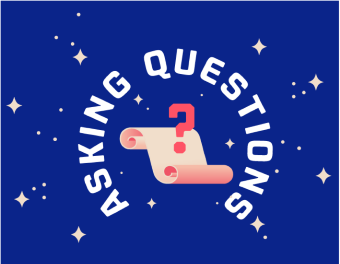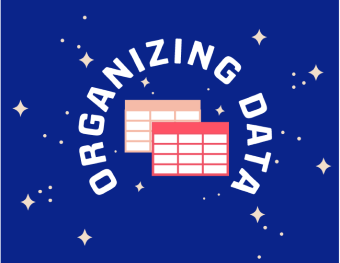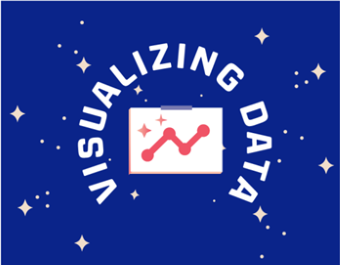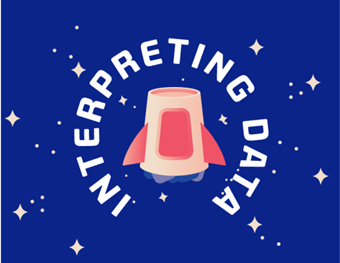Introduction to the Data Science Process – a Club for the Future and Microsoft Hacking STEM collaboration
Hacking STEM is excited to partner with Blue Origin’s nonprofit, Club for the Future, to highlight how a data science process is used to help determine a Go/No-Go for launch of a Blue Origin New Shepard Rocket.
Rock-it with Data Science
Data science has risen to a high level of importance. Now, more than ever, data is utilized to gain a better understanding of the world around us. Advancements in technology allow us to collect larger amounts of data more efficiently and use it in new ways, increasing the need for students to better understand how data science can be applied.
Prepare students to build the future by immersing them in fun and interactive activities as they learn about Excel and the data science process.
The interactive Microsoft Excel workbook guides students through how data scientists engage in a method called the data science process. Use these activities in Excel to explore the process data scientists use to ask good questions, organize, and visualize data and then use the data to make important decisions.
Excel is a tool used around the world to work with data. In these activities, students learn how to use Excel and complete all steps of a mission by engaging in the data science process.
In this mission, students analyze key weather data in determining flight safety parameters for a New Shepard rocket and ultimately make a Go/No-Go decision for launch. Students learn how to use Excel while engaging in this dynamic Data Science Process activity.
During the experience, students first formulate and ask questions related to factors that influence the stability of a rocket as it travels through the atmosphere. Then, using an atmospheric data set, students organize the data using Excel tools to gain meaningful insights. Next, students learn how to create charts and graphs using an AI enhanced feature in Excel.
In the final step, students interpret the visualized data to make a Go/No-Go determination for a rocket launch. The teams report their findings in a brief report to flight control.
With successful completion of all mission steps, students earn a Space Data badge and after completing the experience they earn a certificate.

Step 1 - Asking questions
In Step 1 of the data science process, students ask questions. The questions are directly related to factors that impact the stability of a rocket as it travels through Earth's atmosphere. Then narrow the focus to a single question that can be answered by investigating data.
Age: 11-15 years old
Length: 60 minutes
Lesson highlights:
- Brainstorm questions about factors that could impact rocket launch stability.
- Categorize visual, qualitative, and quantitative data related to a stable rocket launch.
- Develop a question that focuses on a specific data set.
- Determine what data is needed to answer the focus question.
Learning standards:
- NGSS MS-ESS1-3. Analyze and interpret data to determine similarities and differences in findings.
- ISTE 5b. Students collect data or identify relevant data sets, use digital tools to analyze them, and represent data in various ways to facilitate problem-solving and decision-making.
- CSTA 2-DA-09 Collect data using computational tools and transform the data to make it more useful and reliable.
Resources:
- Excel ITDS workbook
- Step 1-4 lesson plans PDF
- Flip prompts
- Video: Overview for students
- Video: Blue Origin scientist
- Video: Introduction Video to Team Blue Origin

Step 2 - Organizing data
Organizing data is the next step in the data science process. Collected sets of data can be extremely large. In the role as a data scientist, you must make the data manageable by using the power of digital tools to better understand the impact of wind on our rocket launch.
Age: 11-15 years old
Length: 60 minutes
Lesson highlights:
- Type, copy, and paste data in Excel cells
- Read sensor data, and manipulate columns of data
- Organize data into a structured table
- Calculate data with formulas in a table
Learning standards:
- NGSS MS-ESS1-3. Analyze and interpret data to determine similarities and differences in findings.
- ISTE 5b. Students collect data or identify relevant data sets, use digital tools to analyze them, and represent data in various ways to facilitate problem-solving and decision-making.
- CSTA 2-DA-09 Collect data using computational tools and transform the data to make it more useful and reliable.
Resources:
- Excel ITDS workbook (same workbook used in Step 1)
- Optional Excel Learning & Skills Practice workbook
- Step 1-4 lesson plans PDF
- Flip prompts
- Video: Blue Origin scientist
- Video: Blue Origin video stories

Step 3 - Visualizing data
Step 3 in this data science process is the creation of visual interpretations of our data, such as charts and graphs. They allow data scientists to see the data in ways that numbers and text just can't provide. The task is to use our organized data from Step 2 and create a chart showing our maximum allowable wind speeds at different elevations.
Age: 11-15 years old
Length: 60 minutes
Lesson highlights:
- Visualize data with column and scatter charts
- Use the Analyze Data feature and learn how to move and resize chart
- Locate different charts from the Insert menu
- Edit titles and labels in a chart
Learning standards:
- NGSS MS-ESS1-3. Analyze and interpret data to determine similarities and differences in findings.
- ISTE 5b. Students collect data or identify relevant data sets, use digital tools to analyze them, and represent data in various ways to facilitate problem-solving and decision-making.
- CSTA 2-DA-09 Collect data using computational tools and transform the data to make it more useful and reliable.
Resources:
- Excel ITDS workbook (same workbook used in Step 1-2)
- Optional Excel Learning & Skills Practice workbook
- Step 1-4 lesson plans PDF
- Flip prompts
- Video: Blue Origin scientist
- Video: New Shepard Human Flight History

Step 4 - Interpreting data
In Step 4 of the data science process, your team interprets the visualized data from Step 3 to make a Go/No-Go determination for a rocket launch. The team reports their findings in a brief report to flight control.
Age: 11-15 years old
Length: 60 minutes
Lesson highlights:
- Learn about visualizing with two types of charts
- Examine a wind speed data chart from a weather balloon
- Use the data available to determine whether the rocket flight is a Go/No-Go for launch
Learning standards:
- NGSS MS-ESS1-3. Analyze and interpret data to determine similarities and differences in findings.
- ISTE 5b. Students collect data or identify relevant data sets, use digital tools to analyze them, and represent data in various ways to facilitate problem-solving and decision-making.
- CSTA 2-DA-09 Collect data using computational tools and transform the data to make it more useful and reliable.
Resources:
- Excel ITDS workbook (same workbook used in Step 1-3)
- Optional Excel Learning & Skills Practice workbook
- Step 1-4 lesson plans PDF
- Flip prompts
- Video: Blue Origin scientist
- Video: To Space and Back with NS 21 Crew
Lesson plan principles
Relevance. Data Science is one of the fastest growing professions, according to the Bureau of Labor Statistics. Every industry needs data analytics – including business in all sectors, healthcare, education, and every form of social programming. Inspiring the advancement of NextGen’s data analytics skills is to stimulate reasoning, discourse, and decision-making, ultimately creating a smarter world for us all.
Equity for All. Multimodal, dynamic, scaffolded instructions support learners at multiple readiness levels and from diverse backgrounds.
Accessibility. Designed to open doors to student participation in the data science revolution, these lessons are supported on any internet-enabled device. Use a larger screen (laptop or desktop) for the best experience.
Aligned to Standards. All activities are aligned to key Next Generation Science Standards (NGSS), International Society for Technology in Education (ISTE) standards, and Computer Science Teacher Association Standards (CSTA) standards.
Continue your learning
Mix and match with these supplemental activities to get your students excited about STEM, space, and data science!
- Analyze astronauts’ photos of Earth to predict climate change with this Hacking STEM + NASA activity.
- Design astro socks to protect astronauts’ feet in microgravity while on the International Space Station with this Hacking STEM + NASA activity.
- Engage in a video discussion experience with Flip. Check out Club for the Future’s page on Flip to explore space-related topics.
- Ignite STEM learning for all students with Minecraft Education. With Artemis Missions, learners explore Newton’s Laws to design and launch a rocket, use code to navigate the Orion space capsule, and work as a team to build a survival base on the moon.
- Send a postcard into space with Blue Origin's Club for the Future. This curriculum is standards-aligned and encourages students to think about a future of life in space to benefit Earth. After completing this activity, students get a special space-flown keepsake.
- Bring space to the classroom with Club for the Future. Explore these classroom activities and curriculum for K-12 educators and parents.
- Research astronaut space food with Search Coach in Microsoft Teams for Education. Get guidance to ask effective questions and discover reliable sources.
- Learn about rockets and rocket science with NASA. With a variety of classroom activities ranging from building a paper rocket to learning about rocket payloads, NASA activities are appropriate for students ages 5 to 18.
- Discover your own insights with a large rockets-based data set in Excel. Explore, visualize, and analyze big data.
Tips for teachers
Use the Excel workbook in Microsoft Teams Create an assignment (Introduction to the Data Science Process) in Microsoft Teams for Education and assign the Excel workbook to individual or small groups of students in a class. Groups turn in one copy of the assignment that can be graded separately or together. Learn how here.
Using Flip in the classroom Flip is a free app from Microsoft where educators create safe, online groups for students to express their ideas asynchronously in short video, text, and audio messages. Promote peer-to-peer learning in your classroom while using the Introduction to the Data Science Process curriculum. Learn how to get started here.
Career corner
Data is used in every career, in new and unexpected ways! Hear from people who work with data in this gallery of short videos on Flip. They discuss their career path and the role data plays in their job.
Want more?
You can integrate other hands-on STEM projects into your classroom! Try projects such as building a robotic hand, making a battery out of a lemon, or measuring water quality. Visit aka.ms/HackingSTEM to learn more.
Have feedback?
We would love to hear your thoughts on the Introduction to the Data Science Process materials! Let us know what works well for you, what could be better, and what you'd like to see in the future.
Saran dan Komentar
Segera hadir: Sepanjang tahun 2024 kami akan menghentikan penggunaan GitHub Issues sebagai mekanisme umpan balik untuk konten dan menggantinya dengan sistem umpan balik baru. Untuk mengetahui informasi selengkapnya, lihat: https://aka.ms/ContentUserFeedback.
Kirim dan lihat umpan balik untuk